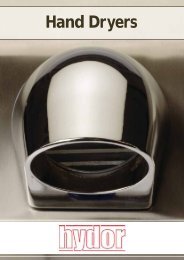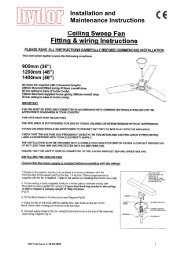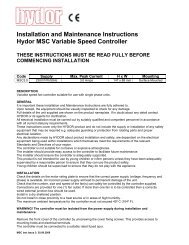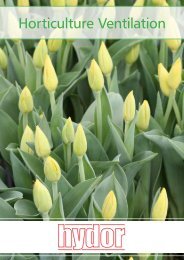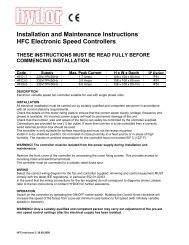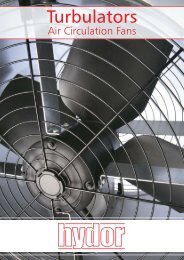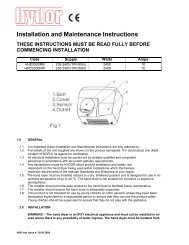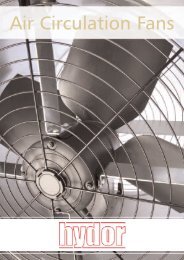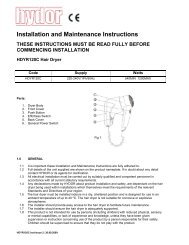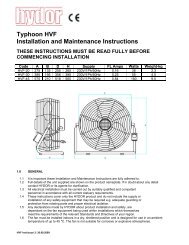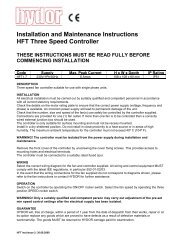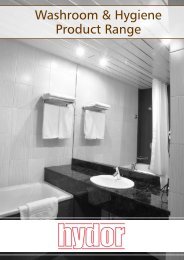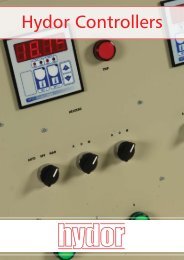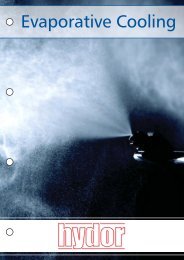Heating & Ventilation for Pigs - Hydor
Heating & Ventilation for Pigs - Hydor
Heating & Ventilation for Pigs - Hydor
You also want an ePaper? Increase the reach of your titles
YUMPU automatically turns print PDFs into web optimized ePapers that Google loves.
<strong>Heating</strong> & <strong>Ventilation</strong> <strong>for</strong> <strong>Pigs</strong>
Introduction<br />
A<br />
As a leading manufacturer of<br />
<strong>Heating</strong> and <strong>Ventilation</strong> products<br />
to the pig sector, <strong>Hydor</strong> is driven<br />
by achieving a system design that<br />
is not only cost effective to the<br />
farmer, but enhances the pigs<br />
per<strong>for</strong>mance at the same time.<br />
Introduction<br />
Since <strong>Pigs</strong> are housed according to their age, the need to understand their precise<br />
heating and ventilation requirements is an important prerequisite of their<br />
environmental control.<br />
<strong>Pigs</strong> require warmth, as well as a dry bed and protection from winter draughts and summer<br />
heat. Furthermore, there are minimum requirements <strong>for</strong> fresh air, space, and the hygienic<br />
conditions to ensure that the pigs accommodation through its growth cycle provide stable,<br />
defined air temperatures, thereby enabling growth of the animal, with feed utilisation being<br />
improved at the same time.<br />
Because of their sensitivity to temperature conditions at different stages of their growth cycle the<br />
right environment ensures pigs display stable behaviour. As social animals, this is an important<br />
facet to their ability to interact with other pigs in the group, as they tend to be kept in large<br />
numbers in one defined area.<br />
2
ction<br />
The need <strong>for</strong> a controlled environment<br />
At <strong>Hydor</strong> we fully appreciate that farmers rearing their pigs within a building rely on the heating<br />
and ventilation equipment and system design to provide the precise com<strong>for</strong>t conditions <strong>for</strong><br />
their pigs.<br />
The most important aspect when designing the heating and ventilation <strong>for</strong> the building is the<br />
per<strong>for</strong>mance and welfare of the pigs, thereby achieving the right balance between installation<br />
costs, reliability of product and the overall running costs.<br />
This brochure provides an insight into the comprehensive range of <strong>Hydor</strong> products<br />
available <strong>for</strong> pig farming applications. From farrowing through to finishing, <strong>Hydor</strong><br />
provides the pig farmer with quality products and system design capabilities to<br />
ensure growth and animal welfare.<br />
Whether it be a refurbishment project, expansion or new build piggery<br />
accommodation, as one of the leading heating and ventilating<br />
manufacturers within the agricultural sector, <strong>Hydor</strong> is confident it can<br />
assist you with the design criteria specified, the right product selection<br />
and controls systems required.<br />
<strong>Hydor</strong> have been manufacturing fans, heaters and controls, whilst<br />
working closely with pig farmers in their system design approach<br />
<strong>for</strong> more than 40 years now. It is this experience that provides the<br />
knowledge, expertise and flexibility to develop bespoke products<br />
and customer confidence in our capabilities.<br />
3
T<br />
Ins<br />
Typical Installations<br />
Farrowing House<br />
There are many approaches to mechanical ventilation system designs<br />
<strong>for</strong> pig buildings, with the classification of the system based on<br />
the air pressure of the enclosure relative to the outside pressure<br />
i.e. the fans blowing into the enclosure<br />
The drawings outlined in this brochure are intended merely to illustrate<br />
some typical arrangements at those differering stages from farrowing to<br />
finishing. These arrangements show typical negative pressure systems, which<br />
operate below outdoor air pressure i.e. fans exhausting from the enclosure.<br />
It must be stressed however that there are many ways in which the design<br />
criteria could be met, and it should not be assumed that the examples<br />
illustrated are the only ones.<br />
It is important to understand that <strong>Hydor</strong> has more than 40 years experience in<br />
the development and design of agricultural ventilation and heating systems,<br />
ensuring our capabilities provide the precise environmental conditions required<br />
by pig farmers in terms of the temperature and air speeds throughout the<br />
pig’s life cycle.<br />
VARC Controller<br />
Roof Mounted Agri-Jet<br />
AGRI-JET<br />
ROOF MOUNTED<br />
‘HEOSS’ Pig Heater<br />
‘HE’ Propeller Fans<br />
COLD AIR<br />
COLD AIR<br />
WHEN REQUIRED<br />
COLD AIR<br />
HE PROPELLER FAN<br />
HE PROPELLER FAN<br />
HOT AIR<br />
HEOSS<br />
PIG HEATERS<br />
CENTRAL PASSAGE<br />
HOT AIR<br />
Figure 1.0<br />
Farrowing House Figure 1.0<br />
With the piglets born in the Farrowing House, the new born piglets require<br />
extra heat, requiring a lot more warmth during the first few days in order to<br />
adjust to the weaner accommodation – a critical part of their growth cycle.<br />
Equally important to understand is that heating <strong>for</strong> the sow and piglets should<br />
be considered separately when determining heating and ventilation as they<br />
require significantly different temperatures.<br />
Because the pig’s growth is critical to its per<strong>for</strong>mance in the future, provision<br />
of the correct temperature in the Farrowing House is particularly important<br />
because of the pig’s sensitivity at this stage.<br />
This particular drawing depicts a Farrowing House with roof inlets and side<br />
extraction where the fans are mounted in the side walls of the building. Air is<br />
drawn through the inlet unit, though a slotted ceiling area into the cubicles<br />
when required <strong>for</strong> ventilation. When heating the units, air will be drawn<br />
through the slot in the passageway into the ‘HEOSS’ pig heater units and<br />
blown into the cubicle, naturally expelling through the outlet. Farrowing Units<br />
only require gentle air movements so as not to disturb the mother and the<br />
piglets. The central air inlet can have adjustable shutters fitted to direct the air<br />
where required.<br />
4
Typical Installations<br />
Weaning House<br />
‘HEOSS’ Pig Heater<br />
Roof Mounted Agri-Jet<br />
‘HE’ Propeller Fans<br />
AGRI-JET<br />
ROOF MOUNTED<br />
HE PROPELLER FAN<br />
AIR INLET<br />
AIR INLET<br />
PASSAGE<br />
HEOSS<br />
PIG HEATER<br />
HEOSS<br />
PIG HEATER<br />
Figure 2.0<br />
Weaning House<br />
At weaning, the pigs are known as ‘weaners’, usually housed in pens holding<br />
a number of pigs, where they remain until they reach the correct weight<br />
where they are moved out to the fattening house. There are many variations<br />
in the design and layout of the Weaner House, although it generally<br />
consists of a central feeding passage with pens on either side and a<br />
dunging area alongside the outside walls. Most weaner accommodation<br />
incorporates heating and ventilation and it is the heating that accounts <strong>for</strong><br />
most of the energy use, because of its importance in the pig’s growth. With<br />
earlier weaning becoming more common place, the use of more heating at<br />
the weaner stage is apparent. Although there are a wide variety of heating<br />
systems available on the market <strong>for</strong> weaner housing systems, <strong>Hydor</strong> provide<br />
the proven ‘HEOSS’ range of heaters <strong>for</strong> Weaner House applications.<br />
With rapid growth at the weaner stage of accommodation the heat output<br />
of a group of pigs begins to increase and temperature requirements<br />
decrease, thereby initiating a gradual change from heating to ventilation<br />
within the building.<br />
<strong>Hydor</strong> is able to provide the controlled environmental conditions to ensure<br />
the automatic operation of both the heating and ventilation systems as the<br />
need arises within the weaner accommodation.<br />
Figure 2.0<br />
Air Inlets<br />
VARC Controller<br />
This typically illustrates this arrangement where the ‘HEOSS’ heater units are<br />
placed under the floor and warm air is blown into the under floor camber<br />
rising through the floor area where the pigs lye, naturally venting through the<br />
roof mounted fan unit. When ventilation is required, warm air is drawn up<br />
through the side inlet units and either directed upwards in winter to drop on<br />
to the floor area, or in summer directed downward onto the area to cool the<br />
pigs and then extracted by the fan, discharging vertically thereby preventing<br />
any dust or muck ingress onto the roof to pollute the water courses.<br />
5
Ins<br />
Typical Installations<br />
Fattening House<br />
AGRI-JET<br />
ROOF MOUNTED<br />
Roof Mounted Agri-Jet<br />
‘HE’ Propeller Fans<br />
HE PROPELLER FAN<br />
AIR INLET<br />
AIR INLET<br />
PASSAGE<br />
DUNG LAYING PIGS LAYING PIGS DUNG<br />
Figure 3.0<br />
Fattening House Figure 3.0<br />
Fattening House – Although the mature pig is more tolerant to a greater<br />
variation in temperatures, the pigs feed intake, growth rate and the efficiency<br />
of its feed conversion are largely dependent on the environmental<br />
temperature within its accommodation.<br />
Although the Fattening House is essentially the same as the Weaning House it<br />
is on a larger scale.<br />
Figure 3.0 illustrates a conventional roof extract, negative pressure system.<br />
Here, air is drawn into the unit through the side inlets and directed either<br />
upwards in winter, allowing the air to fall into the dunging area or<br />
directed down to the dunging area in summer, passing over the pigs<br />
and rising towards the centre of the unit to be exhausted through the<br />
roof mounted fan unit. Dust and foul air are discharged vertically out and<br />
off the unit, thereby preventing fouling of the roof and contamination of<br />
any water courses.<br />
With a larger pig at this stage in its growth cycle, the<br />
heat output increases with the weight and temperature<br />
requirements fall, thus the ventilation systems in finishing<br />
houses require a higher capacity than required in the<br />
farrowing or weaning accommodation.<br />
Air Inlets<br />
The ventilation required at this stage of pig production<br />
means that the selection of fans and the controls, as<br />
well as the reliability and maintenance <strong>for</strong> these systems<br />
is fundamental <strong>for</strong> efficient operation.<br />
VARC Controller<br />
6
tallations<br />
Breeding Sows<br />
Typical Installations<br />
Roof Mounted Agri-Jet<br />
Heavy Hogs<br />
Turbulator<br />
Circulation Fan<br />
‘HE’ Propeller Fans<br />
AGRI-JET<br />
ROOF MOUNTED<br />
Air Inlets<br />
HE PROPELLER FAN<br />
VARC Controller<br />
TURBULATORS<br />
TURBULATORS<br />
AIR INLET<br />
AIR INLET<br />
PASSAGE<br />
PASSAGE<br />
Breeding Sows & Heavy Hogs<br />
The dry and pregnant sows are either housed in pens holding several sows<br />
or in sow stalls, whereby the pigs are housed individually; this has the<br />
advantage of individual feeding without the fear of fighting.<br />
Figure 4.0<br />
Figure 4.0<br />
This typically illustrates a conventional negative pressure, roof extract system.<br />
Air is drawn through the side inlets and directed upwards in winter allowing<br />
the cooling air to fall naturally onto the pigs. In summer the air is directed<br />
towards the stock, combining with the warm air around the pigs and<br />
exhausting though the fan mounted in the roof mounted Agri-Jet Unit.<br />
Foul and dirty air is discharged vertically into the air, preventing fouling of<br />
the room and contamination of any water courses. Additional Turbulator<br />
fans can be introduced to circulate and blow air onto the pigs in hot<br />
summer conditions.<br />
7
H<br />
eating<br />
Heoss Pig Heater<br />
<strong>Heating</strong><br />
Heat is required <strong>for</strong> two principal reasons, first of all to maximise<br />
With three model sizes, <strong>Hydor</strong>’s “Heoss” Pig Heater is a propane gas,<br />
the pigs feed conversion, but also in reducing the mortality<br />
hot air generator manufactured completely in stainless steel.<br />
rate amongst piglets.<br />
The unit consists of a fixed section that is placed in the wall of the room<br />
(usually the wall of the corridor) and a mobile section, the actual<br />
Where the pigs are kept below their lower critical temperature<br />
generator, mounted on the same wall coupling, with it’s upper part<br />
they will convert more of their food into energy as opposed<br />
in the conduit at 90°.<br />
to body weight. Inevitably the heating systems on the market<br />
The fixed section of the heater consists of a key; a regulator to 37 mbar;<br />
are as varied as the building designs <strong>for</strong> Pig Housings.<br />
a gas filter and a conduit at 90° that transverses the wall with an air<br />
baffle. The additional benefit is that the unit completely seals the air<br />
With effective <strong>Heating</strong> and Control products from <strong>Hydor</strong>, the<br />
exit thereby preventing dust ingress.<br />
precise temperature conditions can be carefully<br />
The mobile section weighs only 15kg and is fitted with a quick<br />
maintained <strong>for</strong> the pigs.<br />
connection to connect the gas supply to the regulator.<br />
8
<strong>Heating</strong><br />
Heoss Pig Heater<br />
Figure 5.0<br />
Figure 6.0 Figure 7.0<br />
<strong>Hydor</strong> ‘HEOSS’ Pig Heaters are designed to be located within a pig building<br />
by blowing heated air into those rooms within the farm where it is needed<br />
<strong>for</strong> the pigs, in particular, the Farrowing and Weaning Houses.<br />
Each of the drawings opposite illustrates typical mounting arrangements<br />
<strong>for</strong> the ‘HEOSS’ unit, also highlighting the flexibility in installation.<br />
Figure 5.0 mounted under the floor, heating the room from below.<br />
Figure 6.0 mounted above the ceiling, heating the room from above.<br />
Figure 7.0 mounted into the room, heating the room directly.<br />
Features & Benefits<br />
• Versatility.<br />
• Suitable <strong>for</strong> all types of farms, particularly Pig Farms.<br />
• “HEOSS” works well with low-pressure propane gas supply.<br />
• Where required <strong>Hydor</strong> can provide a 9kw electric model with<br />
identical dimensions.<br />
• Horizontal or vertical mounting arrangement.<br />
• The heat output is infinitely variable from 1.4 KW to 10 KW via<br />
a 0-10 volt control signal. Automatic OFF switching is optional.<br />
•<br />
The Unit automatically resets after a power failure, with illuminated<br />
lights indicating the operational status of the “HEOSS” unit. The ignition<br />
circuits are isolated from the main electrical circuit <strong>for</strong> safety and EMC<br />
Interference legislation.<br />
Installation<br />
• Very simple and economical.<br />
• HEOSS is <strong>for</strong> outside, inside or corridor installations. The unit can be<br />
installed on the exterior of the Piggery, the interior, <strong>for</strong> example,<br />
Weaner accommodation, or, the most common location, the corridor<br />
or central passageway.<br />
•<br />
Horizontal and vertical position allowing the installation where it is most<br />
convenient or where space is at a premium.<br />
<strong>Heating</strong> Quality<br />
• Homogeneity – By progressive heating, this allows “HEOSS” to maintain<br />
the desired temperature <strong>for</strong> the accommodation with oscillations of less<br />
than 0.5°C.<br />
• The air introduced is a dry air, which improves the environmental quality<br />
by vastly diminishing the humidity of the air and the beds.<br />
9
<strong>Heating</strong><br />
Heoss Pig Heater<br />
Portability and Economy<br />
• With a fixed section of the Pig Heater <strong>for</strong> each room, as well as a transportable section, the unit can<br />
be disconnected and moved from one room to another, leaving the gas supply and the inlet section<br />
in place, thereby utilising the heater section to its maximum potential in other parts of the pig<br />
building. If the pig farmer does not need to heat all of the rooms at the same time, he can<br />
determine the number of heaters to order. Normally 50% of the rooms require heating, which<br />
means only investing in additional fixed utility lines and inlet sections.<br />
Resistance<br />
• Unit is constructed from stainless steel <strong>for</strong> longevity of use, as well<br />
as being hygienic and easy to clean, particularly the burner and<br />
ventilation parts.<br />
• The electrical and electronic components are protected against<br />
humidity and the corrosive atmosphere, which is particularly<br />
prevalent in a Pig Farm.<br />
Security<br />
• By producing the flame outside the room, this can increase safety on<br />
the farm thereby diminishing the risks associated with the use of gas.<br />
• Potential reduction in the insurance costs on the farm.<br />
• The unit works with low-pressure gas.<br />
In essence, <strong>Hydor</strong> “HEOSS” Pig Heaters are-<br />
• Easy to install.<br />
• Easy to clean.<br />
• Easy to transport from one room to another.<br />
• Work with bottled gas.<br />
Quite simply it is one of the highest quality and lowest cost pig<br />
heaters on the agricultural market today.<br />
10
entilation<br />
<strong>Ventilation</strong><br />
G Good ventilation design is a vital and integral part<br />
of the design process of any livestock building.<br />
At <strong>Hydor</strong>, we strive to provide a ventilation system <strong>for</strong> pig farms that accomplishes<br />
the following:<br />
• Provide the desired amount of fresh air, without draughts, to all parts of<br />
the building.<br />
• Maintain temperatures within desired limits.<br />
• Maintain relative humidity within desired limits.<br />
• Ensure ammonia levels are below specified levels to assure worker safety.<br />
<strong>Hydor</strong>’s objective in ventilation system design of buildings is to maintain a healthy<br />
environment <strong>for</strong> animals and workers in the facility.<br />
After more than 40 years of creating the right environmental conditions <strong>for</strong> livestock<br />
producers, <strong>Hydor</strong> can boast a thing or two on ventilation systems and design.<br />
Take a look at some of the specific products within our comprehensive range <strong>for</strong> pig<br />
farming applications such as the brand leading High Efficiency “HE” Propeller fan,<br />
Roof Mounted Agri-Jets, or Turbulators, as well as Air Inlets and VARC Controllers.<br />
11
E Fans<br />
HE Fans<br />
A modern high quality range of agricultural propeller fans<br />
designed to pass large volumes of air with minimum use<br />
of energy.<br />
The <strong>Hydor</strong> HE fan range has been designed specifically <strong>for</strong> use in agricultural applications<br />
such as pig farms where corrosive environments are particularly evident.<br />
With a heavy duty construction, the HE fans principal benefit is the propeller shaped<br />
stainless steel blades which scoop air and move it away from the fan blade - Blade<br />
tip clearance design enhances HE fan per<strong>for</strong>mance alongside large volume<br />
air movement.<br />
12
E Fans<br />
HE Fans<br />
Suggested number of <strong>Pigs</strong> per installed <strong>Hydor</strong> HE Type of<br />
Livestock<br />
<strong>Pigs</strong><br />
weight<br />
kg<br />
Static Pressure @ 50Pa<br />
Features & Benefits<br />
Fan Diameter (mm) 315 350 400 450 500 630<br />
Supply (phase)<br />
Air Volume m 3 /h<br />
m 3 /h/kg<br />
Single Single Single Single Three Single Three Single Three<br />
1450 2520 3680 5120 5120 8140 8140 10600 10600<br />
Suggested Number of Livestock per Fan Type<br />
Early Weaners 23.00 1.88 34 58 85 118 118 118 188 245 245<br />
Pork <strong>Pigs</strong> 68.00 1.88 11 20 29 40 40 63 63 83 83<br />
Heavy Hogs 91.00 1.88 8 15 22 30 30 48 48 62 62<br />
Table 1.0 illustrates the suggested number of pigs that can be adequately ventilated with <strong>Hydor</strong> ‘HE’ Propeller fans, thereby being within the Lower and<br />
Upper critical temperatures of the pig.<br />
• Quality robust construction<br />
incorporating stainless steel<br />
impeller.<br />
• Available in 9 sizes<br />
“315/355/400/450/500/<br />
560/630/710/760”.<br />
• Very efficient power<br />
consumption.<br />
• Reliable with high volume<br />
air movement.<br />
• Waterproof Junction Box and<br />
3 metre cable.<br />
• Motors are particularly<br />
cool-running, constructed<br />
with a finned aluminium<br />
casing to give excellent<br />
heat dissipation.<br />
• Three year (Conditional)<br />
extended warranty on all<br />
our motors.<br />
• Optional EC con<strong>for</strong>ming<br />
motor/propeller side guards<br />
• Motors are weatherproofed<br />
to IP55.<br />
• Suitable <strong>for</strong> Form ‘A’ or Form<br />
‘B’ operation.<br />
• Ex-stock single phase and<br />
three phase fans.<br />
• Diaphragm mounted units<br />
without rings <strong>for</strong> special<br />
applications.<br />
• Low noise level.<br />
• Long service life.<br />
• Quick and easy assembly.<br />
Accessories<br />
• Motor or Propeller side wire<br />
guards to BS848 Part 5 finished<br />
in red powder coat to RAL7031.<br />
• Air Operated louvre shutters<br />
available in Aluminium /<br />
Alu-Zinc and plastic.<br />
• A full range of both automatic<br />
and manual infinitely variable<br />
or stepped trans<strong>for</strong>mer<br />
type controls.<br />
13
oof<br />
Agri-jet<br />
Mounted<br />
Roof Mounted <strong>Ventilation</strong> Units<br />
F Farmers have used the brand leading range of Agri-Jet units <strong>for</strong> many pig housing applications.<br />
The Roof Mounted Unit is a high velocity jet extraction unit <strong>for</strong> on or off-ridge installations.<br />
The design of the inlet ensures that it operates at high efficiency by maximising air flow and<br />
operating at low back pressure - minimising operating costs.<br />
Stale air is expelled through the cowl to a height of approximately 60 feet, ensuring that any<br />
dust, moisture, ammonia and smells are dissipated as they leave the pigs accommodation.<br />
Features & Accessories<br />
• There are five standard sizes “450mm, 500mm, 630mm, 710mm<br />
and 760mm.”<br />
• Roof mounted units are supplied complete with a <strong>Hydor</strong> HE High<br />
efficiency Propeller fan, easily accessible <strong>for</strong> cleaning and maintenance.<br />
• Supplied as ready-assembled units <strong>for</strong> On-ridge or Off-ridge installation.<br />
• Low Silhouette design provides tidy and unobtrusive appearance.<br />
• High Velocity exhaust jet of approximately 60 feet ensures no roof<br />
dust deposit.<br />
• Minimal back pressure ensures maximum fan efficiency.<br />
• Roof mounted units can be opened using a cable system as a fail<br />
safe contingency.<br />
• Units can be supplied <strong>for</strong> flush mounting to<br />
the ceiling line, or with circular tube trunk<br />
extensions according to customer preference.<br />
• GRP bell mouth inlets are available <strong>for</strong> fitting<br />
to the bottom off the extension tubes <strong>for</strong><br />
maximum efficiency in aerodynamic design.<br />
• Hinged fan assembly to facilitate<br />
shaft cleaning.<br />
• Plastic thermal barrier trunk reduces noise<br />
levels and in-house condensation.<br />
• Light Baffle boards to diffuse the light.<br />
14
nlets<br />
High Flow Air Inlet<br />
Maximum Resistance Inlets<br />
I In a mechanical ventilation system, the size and operation of the piggery will determine the rate of air changes required.<br />
The uni<strong>for</strong>mity of air distribution, on the other hand, depends primarily on location, design and adjustment of the air<br />
intakes in exhaust systems or the air outlets in pressure systems.<br />
It is especially important to maintain enough inlet velocity during the<br />
colder weather so that the incoming air is mixed or blended sufficiently<br />
with the warm room air be<strong>for</strong>e it reaches the pigs. The opening, or<br />
cross sectional area, of the air inlet should be based upon the capacity<br />
of the fans. If the inlet area is too great, cold air will enter at low<br />
velocity, causing it to settle to the floor and induce drafts, which<br />
pigs are sensitive too.<br />
<strong>Hydor</strong> high flow inlets, constructed of hygienic, easy to clean,<br />
polyurethane foam with aerofoil blade section are designed to direct<br />
the incoming air to the most advantageous place <strong>for</strong> the pigs welfare.<br />
By directing cooling air down onto the dunging areas, this encourages<br />
the pigs to use this specific area whilst allowing the air to temper as it<br />
passes over stock.<br />
Inlets can be controlled individually or in sections. Accurate control of<br />
these is essential.<br />
Features & Benefits<br />
• A very high degree of insulation<br />
• A strong structure with a low<br />
weight.<br />
• Quick and easy mounting<br />
• Easy to handle (adjusting,<br />
gluing etc).<br />
• Easy to clean.<br />
• Environmentally desirable.<br />
• Highly resistant to chemicals,<br />
aggressive gases and dry rot.<br />
• Inlets constructed from durable<br />
polyeurethane foam.<br />
• Simple to install either in a new system,<br />
or as a retro-fit to upgrade an existing<br />
system design.<br />
• Inlets can be supplied <strong>for</strong> either wall or<br />
ceiling mouthed applications.<br />
15
Turbulator<br />
High Quality Recirculation Fans<br />
H <strong>Hydor</strong> Turbulator fans are specifically designed to have a long<br />
throw and move air efficiently to give a measure of control<br />
over temperature and humidity in pig housing, aswell as a<br />
variety of other applications <strong>for</strong> farming.<br />
Features<br />
• Rust proof wire guards <strong>for</strong><br />
employee safety.<br />
•<br />
Waterproof Junction Box and<br />
3 metre cable.<br />
16
or<br />
• Rust proof air straightener <strong>for</strong> long<br />
axial air flow.<br />
• Suitable Standard 230v Single<br />
Phase Supply.<br />
• Stainless steel duct supplied with<br />
suspension eyes and chain <strong>for</strong><br />
ease of mounting.<br />
• Large Range of Thermostats and<br />
speed controllers available<br />
• 12 Months Product Warranty<br />
Turbulator<br />
The <strong>Hydor</strong> range of Turbulators, constructed with stainless steel casings,<br />
with high efficiency, lightweight motors and non corrosive plastic<br />
propellers offer various sizes from 355mm to 630mm diameter. The units<br />
are suitable <strong>for</strong> all year round ventilation and <strong>for</strong> movement of air within<br />
pig units giving evenness of temperature throughout the unit and<br />
removing condensation<br />
in the fattening and heavy hog houses, by circulating the air, thereby<br />
improving the pig's environment at low cost and power consumption.<br />
There are a number of distinct benefits <strong>for</strong> piggery applications with this<br />
particular product, namely –<br />
1. Control of insects – Many insects and flies are discouraged by a<br />
constant airflow throughout the pig building which is created by<br />
Turbulator fans.<br />
in their housing. Turbulators gently circulate fresh air evenly throughout<br />
the entire building, which culminates in a healthier environment <strong>for</strong><br />
the pigs.<br />
3. A reduction in heat stress, whereby growth loss is reduced from heat stress.<br />
4. A constant airflow will ensure the pig building is kept dry by increasing<br />
evaporation of moisture in the air.<br />
5. A reduction in the heat stress of pigs when using Turbulators to circulate<br />
the air can enhance their reproductive efficiency.<br />
6. Air circulation moves ammonia fumes away from the pigs, thereby<br />
circulating gases to a higher level within the building, which in<br />
turn means that exhaust fans will remove them from the building<br />
more efficiently.<br />
2. Overcomes dunging problems – Where the ventilation rates become<br />
too low, pigs will tend to congregate wherever the oxygen level is best<br />
Accessories<br />
• A full range of both automatic and<br />
manual infinitely variable controllers.<br />
• Available in stainless steel<br />
(non-stocked / made to order).<br />
• A full range of electronic /<br />
manual thermostats.<br />
Extra chain/cable available -<br />
please notify at time of ordering.<br />
17
Controllers<br />
Controlling your environment<br />
A A first class control system is essential <strong>for</strong> the effective operation of heating<br />
and ventilation equipment in order to achieve precise temperatures within a<br />
building or part of that building. By achieving accurate temperature controls,<br />
this minimises the potential wasteful use of energy, culminating in improved<br />
food conversion of pigs and their growth rates. In addition a more stable<br />
temperature will have an overall influence on per<strong>for</strong>mance.<br />
18
s<br />
The <strong>Hydor</strong> VARC range of Automatic controllers are designed to operate<br />
small numbers of fans, offering infinitely variable speed control, with or<br />
without low temperature shut off and / or heater interlock to maintain<br />
the correct environment at minimal cost.<br />
The <strong>Hydor</strong> VARC Infinitely Variable Fan Speed Control is a simple to use,<br />
easy to install unit which is suitable <strong>for</strong> controlling up to six fans from a<br />
correctly rated and protected single phase 200-240 Volt 50Hz AC supply.<br />
Designed to maintain a set temperature in the required area, they are<br />
ideal <strong>for</strong> farrowing, weaning and smaller sow houses.<br />
The VARC units feature a ‘Temperature Setting’ dial and a ‘Minimum<br />
Speed’ dial, an individual suitably rated miniature circuit breaker <strong>for</strong> each<br />
fan to act as an On/Off Switch whilst protecting the fan motor, and<br />
indicator lights; easily replaced control card and drive units. The unit is<br />
supplied with a suitable temperature sensing device.<br />
A normal continuous version where fans run continuously, varying in speed,<br />
between the set minimum and full speed to maintain the required<br />
temperature, whilst maintaining a minimum throughput of fresh air.<br />
The P off-switching version where fans switch off when the temperature<br />
inside the pig unit dips below the minimum speed temperature setting,<br />
allowing the internal temperature to recover as soon as possible, or<br />
reducing the heating requirement. This particular version is more suitable<br />
<strong>for</strong> Farrowing Units where low air requirements are needed.<br />
The VARC unit is housed in a metal powder coated enclosure finished in<br />
standard grey /brown and can be installed either inside the piggery or<br />
outside in one of the passageways.<br />
Dimensions are either 300mm by 250mm by 150mm or 400mm by<br />
300mm by 150mm depending on the number of fans.<br />
The Control is available in various <strong>for</strong>ms to suit the particular application<br />
within the building.<br />
Features & Benefits<br />
• Set Temperature Control which allows the required temperature of the<br />
unit to be selected between 5ºc and 45ºc.<br />
• Minimum Speed Control which allows the operator to select a<br />
minimum speed between 10% and 100%. This is the minimum speed<br />
the fans will operate at irrespective of the temperature in the piggery.<br />
On “off switching” versions where the fans will switch off and re-start<br />
at this speed setting. The fans are normally factory set at <strong>Hydor</strong> to<br />
operate over a 5ºc temperature differential between 10% and 100%.<br />
• Miniature Circuit Breaker which is suitably current rated <strong>for</strong> the size of<br />
fan being controlled, which acts as a on and off fan selection switch<br />
whilst protecting the fan motor from an overload condition.<br />
• An internal control card features preset controls <strong>for</strong> calibrating the fan<br />
speeds, the temperature and setting the differential. The differential can<br />
be varied between 1ºc and 10ºc.<br />
19
www.hydor.co.uk<br />
<strong>Hydor</strong> Ltd . Unit 8 . Parkers Close . Downton Business Centre<br />
Downton . Salisbury . Wiltshire . SP5 3RB<br />
Tel: +44 (0) 1725 511422 . Fax: +44 (0) 1725 512637<br />
e-mail: info@hydor.co.uk . www.hydor.co.uk<br />
PHV/02-05-06/01<br />
FANS CONTROLS SYSTEMS



